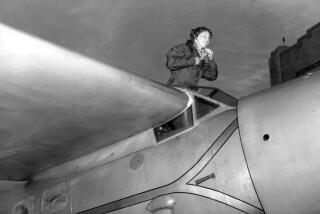Earhart’s Plane and Shoe Reportedly Found on Atoll : Pacific: The pioneer woman aviator disappeared in 1937. Space-age technology may have solved the mystery.
- Share via
HOUSTON — A team of aviation buffs using space-age technology has found the remains of Amelia Earhart’s airplane on a remote South Pacific island, the Houston Post reported Saturday.
The fuselage remnants were found in a search of the jungle on the 3 1/2-mile-long atoll of Nikumaroro in the island nation of Kiribati.
The plane segment and a Size 9 shoe--Earhart’s size--were discovered during an October expedition, said Richard Gillespie, executive director of TIGHAR, the International Group for Historic Aircraft Recovery.
Earhart was the first woman to fly across the Atlantic and set a number of aviation speed and altitude records, making her a heroine and celebrity of the 1930s.
Earhart and her navigator, Fred Noonan, disappeared in their twin-engine Lockheed 10-E Electra on July 2, 1937, during her bid to become the first woman to fly around the world.
They disappeared between New Guinea and Howland Island. They planned to use Howland as a way station to Honolulu and Oakland, thus completing the mission.
Gillespie said the articles found on Nikumaroro were sent for analysis to a National Transportation Safety Board expert, who verified them as Earhart’s, the newspaper said.
There was no one at the agency’s Washington office Saturday who could confirm the report.
Gillespie, who did not further describe the remnant of the plane, said he will present the findings Monday at a news conference in Washington.
“We will present proof that the Earhart mystery has been solved,” he said. “It’s been a long, difficult, expensive project.”
The newspaper story did not explain how the plane was found. But last June, Oceaneering International, a Houston-based company, said that it had been hired by TIGHAR, a nonprofit foundation, to use a sophisticated underwater sonar device to scan the ocean bottom for remains.
The company employed the same technology to find pieces of the space shuttle Challenger in the Atlantic after it exploded shortly after takeoff in January, 1986, and, in 1990, a door that fell from a United Airlines jet into water 14,400 feet deep in the Pacific.
Oceaneering representatives could not be reached for comment Saturday.
Gillespie said last summer that TIGHAR’s theory was that Earhart and Noonan got lost after they took off from Lae, New Guinea, headed for Howland Island, ran out of fuel and crash-landed on the coral shelf surrounding Nikumaroro.
The aircraft, buoyed by its big, empty fuel tanks, probably floated on the reef for several days before sinking somewhere off the coast, he said. The coral is dry at low tide but covered by three to four feet of water when the tide comes in.
A 1989 TIGHAR expedition to Nikumaroro found an aluminum box used by navigators to store maps. The box appeared to be similar to one in an old photograph of the ill-fated plane, Gillespie said.
During that expedition, the San Francisco Chronicle reported, TIGHAR team members sought information on the reported discovery by British colonists of a female skeleton next to American shoes and a cognac bottle within a few years after Earhart’s disappearance. There were no native women on the island at the time.
According to the story, the island’s Irish magistrate immediately thought of Earhart and put the bones in a gunnysack and left for Fiji to get positive identification. When the magistrate died during the trip, superstitious sailors were said to have thrown the gunnysack overboard.
Gillespie said Earhart and Noonan may have survived on the island until 1938, when a severe drought struck.
When her plane disappeared, President Franklin D. Roosevelt ordered a search, and Navy ships reported hearing distress signals for three days.
TIGHAR theorized that through a navigational error, Earhart and Noonan missed their target of Howland Island and crash-landed on or near Nikumaroro, 350 miles away.
Tom Willi and Tom Gannon, retired military navigators, developed the theory after studying potential routes and plotting transmissions sent on Earhart’s frequency. TIGHAR, based in Wilmington, Del., funded the $750,000 search project.
Gannon said the team was “90% sure” that the fuselage was part of Earhart’s plane when they first found it.
The woman’s shoe--a Cat’s Paw brand popular during the 1930s--sealed any doubts, he said.
Earhart’s disappearance has led to speculation for the past 55 years. Among the theories was that she was spying on the Japanese for the United States and was captured and died in captivity.
More to Read
Sign up for Essential California
The most important California stories and recommendations in your inbox every morning.
You may occasionally receive promotional content from the Los Angeles Times.













